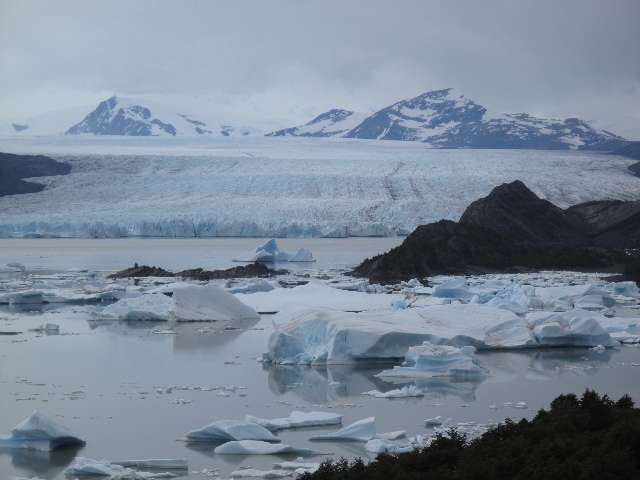
Reconstructing the Holocene glacial varations of the Hielo Patagonico Sur at Torres del Paine
Patagonia, Chile
Reconstructing the Holocene glacial variations of the Hielo Patagonico Sur at Torres del Paine (51oS), southern South America
Juan Luis García, February 2010
Uncovering the timing and extension of glaciers during the Holocene provide clues on the climate variability and its causes during this period. Since several decades glaciers records have been studied to understand climate shifts and atmospheric circulation patterns. Dating and constructing new Holocene glacial chronologies is key to have a better understanding of interhemispherical synchronicity of climate change and the influence of regional climate in glacier dynamics. In order to expand the sparse Holocene glacier record at southern South America, Víctor García and myself spent the last two weeks of February 2010 in the Tyndall and Zapata glacial catchments at the western boundaries of the Torres del Paine National Park (51º), southern Patagonia. I chose these two glaciers because they preserved on their forelands an astonishing sequence of moraines that depict Holocene ice fluctuations. We use cosmogenic-exposure dating for dating moraines and therefore these sites comprise an excellent chance to uncover local glacial/climate history for the Holocene. The goal was to map and sample the moraines for 14C and principally 10Be cosmogenic-exposure dating.
Glacier Tyndall System (February 16-21
After air traffic delays and missing connections between Bangor ME (45ºN) and Punta Arenas (55ºS) I finally landed in Punta Arenas at 02:30 am. Here I met Víctor, who was waiting for me with a rented truck and all the essentials supplies we needed to begin our expedition into the remote glacial systems of the southern Andes. Our time was restricted and needed to drive during that night so we catch the cuter 21 de Mayo next morning at 07:30 am that would take us from Puerto Natales to Puerto Toro, where the Río Serrano meets the Seno Última Esperanza in the Pacific Ocean.
After three hours of navigation along the fjord we got Puerto Toro and took a zodiac and sailed up-river the Río Serrano for one hour through one of the most astonishing areas of the region. After reaching the property of Pekin Guerrero, organized our gear and meal for the next three days and rode horses to our final destination at the front of Lago Geike. Once there, we settled our camp and finally rest during the night.
We had two complete days of work in the area with the goal of mapping and sampling the three moraine ridges that made-up the local Holocene record. Our best findings here were a dead forest incorporated into the moraine that encloses Lago Geike and wood pieces embedded in the outwash deposits associated with the intermediate moraine. These wood remains will help to uncover the age of last glacial advance in the region. The exuberant forest in the area limited the existence of suitable boulders to be sampled for 10Be cosmogenic-exposure dating. Nevertheless, we discovered new areas to visit in the future located higher in the mountain where no vegetation is present and Holocene records may be excellent.
Glacier Zapata System (February 22-March 2)
The next day after leaving the Geike area with horses and zodiac up-river Río Serrano, we walked for four hours to Campamento Zapata. We spent the next seven days there. This was the most successful part of the expedition. Two glaciers occur here. One is Glacier Pingo, whose ice terminus ends in a glacial lake. The other is Glacier Zapata, which is a sub-lobe of Glacier Tyndall. Whereas two-to-three moraine ridges enclose Lago Pingo, the Glacier Zapata foreland includes a moraine field with more than 10 ridges. We began our mapping and sampling program in Zapata because there was more work to get done in this basin and access was easier. In Zapata, we found numerous moraines often with suitable boulders for 10Be cosmogenic-exposure dating and we sampled a total of fifteen boulders. Every day we walked along the moraines that follow a curved geometry that identifies the original perimeter of the Zapata ice front. Not as clear as in the Geike area, the ice here built three moraine systems during the Late Holocene. While there, we enjoyed an uncommon stable warm weather together with the mysterious lenga forests and intimate visits of condors and huemules.
We left the last two days for working at the moraine system of Lago Pingo. Nonetheless, in order to get here one needs to cross a river. Stream discharge here is highly variable and linked with daily temperatures. The last days of February were warm and made the river grow wide and strong. Although we wait for a better, cooler, day it never came. Our planned day for coming back home found us without reaching Lago Pingo. This obligates myself to come back in the future and spend a third season in this wonderful landscape and continue to work unraveling the mysteries of the climate during the Holocene.


